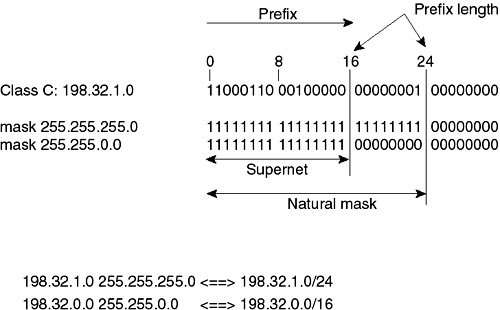Networking Routing Fundamentals
The major benefit of CIDR is that it enables continuous, uninterrupted growth of large networks. CIDR enables routers to group routes to cut down on the quantity of routing information carried by a network’s routers. With CIDR, several IP networks appear to networks outside the group as a single, larger entity. CIDR eliminates the concept of class A, B, and C networks and replaces this with a generalized “IP prefix.” Some of the benefits of using CIDR within your network are as follows:
What Do Those /16s and /24s Mean?/16 and /24 refer to the number of bits of the network part of the IP address. A former class B address might appear as 172.24.0.0/16, which is the same as 256 class Cs, which can appear as 192.200.0.0/16. A single class C appears as 192.201.1.0/24 when using CIDR. This new “look” to IP addresses consists of an IP address and a mask length. A mask length is often called an “IP prefix.” The mask length specifies the number of left-most contiguous significant bits in the corresponding IP address. For example, the CIDRized IP address of 172.24.0.0/16 indicates you are using 172.24.0.0 255.255.0.0. The /16 is an indication that you are using 16 bits of the mask when counting from the far left. Figure 2-8 demonstrates an excellent example of how CIDR defines its mask.
Important CIDR TermsA network is called a supernet when the IP prefix contains fewer bits than the network’s natural mask. For example, the class C address 200.34.5.0 has a natural mask of 255.255.255.0. This address can also be represented in CIDR terms as 200.34.0.0/16. Therefore, because the natural mask is 24 bits and the CIDR mask is 16 bits (16 < 24), this network is referred to as a supernet. Simply put, supernets have an IP prefix shorter than the natural mask. This enables the more specific contiguous networks—such as 200.34.5.0, 200.34.6.0, and 200.34.7.0—to be summarized into the one CIDR advertisement, which is referred to as an aggregate. Simply put, aggregates indicate any summary route. Figure 2-9 demonstrates how CIDR can be used to benefit your network by reducing routing tables.
IP ClasslessUse ip classless in your routers and use a default route inside your Autonomous System (AS). The ip classless command prevents the existence of a single “subnet” route from blocking access via the default route to other subnets. CIDR Translation TableTable 2-5 provides you with some basic CIDR information already laid out.
Manually Computing the Value of a CIDR IP PrefixIf you manually wanted to compute the CIDR IP prefix, then refer to the following (in which a subnet that is five bits long is used). Example: 166.38.0.0/19
| ||||||||||||||||||||||||||||||||||||||||||||||||||||||||||||||||||||||||||||||||||||||||||||||||||||||||||||||||||||||||||||
EAN: 2147483647
Pages: 200

